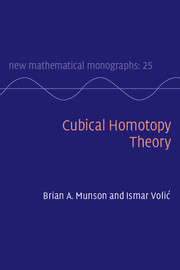9 - Cosimplicial spaces
from PART II - GENERALIZATIONS, RELATED TOPICS, AND APPLICATIONS
Published online by Cambridge University Press: 05 October 2015
Summary
Cosimplicial spaces were championed by Bousfield and Kan [BK72a] who, in the process of defining R-completions (see Example 9.2.8), initiated a careful study of their properties. The main feature of cosimplicial spaces is that one way to construct the homotopy limit of a diagram is to first perform its “cosimplicial replacement”. Theorem 9.3.3 says that the “totalization” of this cosimplicial replacement is equivalent to the homotopy limit of the original diagram. In fact, because of this result, the cosimplicial approach is often taken as the definition of the homotopy limit.
For our purposes, defining homotopy limits this way requires too much extra machinery, but there are other important properties of cosimplicial spaces that we wish to explore, and they are undoubtedly a useful organizational tool. Most importantly, a feature that is important in the context of this book is that the results in Section 9.4 say that any diagram can be turned into a sequence of punctured cubical ones by passing through a cosimplicial diagram. Thus studying homotopy limits in some sense reduces to studying punctured cubical ones. We will elaborate on this at the end of Section 9.4.
Another quality of cosimplicial spaces is that they come equipped with spectral sequences converging (under favorable circumstances) to the homology and homotopy groups of their totalizations. This gives an important computational tool for studying homotopy limits of diagrams. We will describe these spectral sequences in Section 9.6 and will see some of their applications in Section 10.4.
Because of the duality of cosimplicial and simplicial spaces as well as homotopy limits and colimits, this entire chapter could have been written in terms of simplicial spaces and homotopy colimits. The choice of taking the cosimplicial/ homotopy limit point of view is due to the fact that the authors initially came to the subject that way. In addition, the applications in Chapter 10 use the language of homotopy limits more than homotopy colimits. Nevertheless, we will in Section A.1 list some of the most important simplicial/homotopy colimits versions of the constructions and results from this chapter.
Some additional topics on cosimplicial spaces, such as the model category structure on the category of cosimplicial diagrams, can be found in [BK72a, GJ99]. Other references are provided throughout the chapter.
Information
- Type
- Chapter
- Information
- Cubical Homotopy Theory , pp. 443 - 501Publisher: Cambridge University PressPrint publication year: 2015
